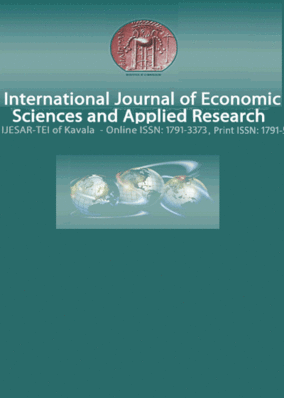Is there a relationship between fiscal sustainability and currency crises? International evidence based on causality tests
Part of : International journal of economic sciences and applied research ; Vol.7, No.1, 2014, pages 69-87
Issue:
Pages:
69-87
Author:
Abstract:
This paper uses Granger causality tests on a fiscal sustainability indicator (FSI) and currency crises for 17 countries to evaluate the direction of causality between the FSI and currency crises. The FSI developed by Croce and Juan-Ramón (2003) is used. Also, different definitions for currency crises are used to evaluate whether they induce different results in the analysis. In general, the results suggest evidence of causality between the lagged FSI and currency crises.
Subject (LC):
Keywords:
currency crisis, foreign exchange, fiscal sustainability, granger causality
Notes:
Περιέχει πίνακες, εικόνες και βιβλιογραφία
References (1):
- Aziz, J., Caramazza, F., and Salgado, R., 2000, ‘Currency crises: In search of commonelements’, Working Paper WP/00/67, International Monetary Fund.Bird, G. and Mandilaras, A., 2006, ‘Regional heterogeneity in the relationship between fiscalimbalances and foreign market pressure ’, World Development, 34, 7, pp. 1171-1181.Broome, S. and Morley, B., 2004, ‘Stock prices as a leading indicator of the East Asianfinancial crisis Journal of Asian Economics, 15, pp. 189-197.Burkart, O. and Coudert, V., 2002, ‘Leading indicators of currency crises for emergingcountries’, Emerging Markets Review, 3, pp. 107-133.Burnside, C., Eichenbaum, M. and Rebelo, S., 2000, On the fundamentals of self-fulfillingspeculative attacks’, Working Paper 7554, National Bureau of Economics Research.Burnside, C., Eichenbaum, M. and Rebelo, S., 2003, On the fiscal implications of twincrises’, In Dooley, M. P. and Frankel, J. A., editors, Managing Currency Crises inEmerging Markets, University of Chicago Press, Chicago.Burnside, C., Eichenbaum, M. and Rebelo, S., 2006, ‘Government finance in the wake ofcurrency crises’, Journal of Monetary Economics, 53, pp. 401 -440.Chang, R. and Velasco, A., 2001, ‘A model of financial crises in emerging markets’,Quarterly Journal of Economics, 116, pp. 489-514.Corsetti, G. and Mackowiak, B., 2005, ‘A fiscal perspective on currency crises and theoriginal sin’, In Eichengreen, B. and Hausmann, R., editors, Other People’s Money:Debt Denomination and Financial Instability in emerging Market Economies, TheUniversity of Chicago Press, Chicago.Corsetti, G. and Mackowiak, B., 2006, ‘Fiscal imbalances and the dynamics of currencycrises’, European Economic Review, 50, pp. 1317-1338.Crepo-Cuaresma, J. and Slacik, T., 2007, ‘Predicting currency crises using the termstructure of relative interest rates: Case studies of the Czech Republic and Russia’,Focus on European Economic Integration, 1, pp. 135-149.Croce, E. and Juan-Ramón, V. H., 2003, ‘Assessing fiscal sustainability: A cross-countrycomparison’, Working Paper WP/03/145, International Monetary Fund.Daniel, B. C., 2001, ‘A fiscal theory of currency crises’, International Economic Review,42, 4, pp. 969-988.Davidson, R. and MacKinnon, J. G., 1989, ‘Testing for consistency using artificialregressions ’, Econometric Theory, 5, 3, pp. 363-384.Eichengreen, B., Rose, A. K. and Wyplosz, C., 1994, ‘Speculative attacks on peggedexchange rates: An empirical exploration with special reference to the EuropeanMonetary System’, Working Paper 4898, National Bureau of Economics Research.Eichengreen, B., Rose, A. K. and Wyplosz, C., 1996, ‘Contagious currency crises: Firsttests’,Scandinavian Journal of Economics, 98, pp. 463-484.Flood, R. and Garber, R, 1984, ‘Collapsing exchange rate regimes: Some linear examples’,Journal of International Economics, 17, pp. 1-13.Flood, R. and Marion, N., 1996, ‘Speculative attacks: Fundamentals and self-fulfillingprophecies’, Working Paper 5789, National Bureau of Economic Research.Frankel, J. A. and Rose, A. K., 1996, ‘Currency crashes in emerging markets: An empiricaltreatment’, Journal of International Economics, 41, pp. 351-366.Frankel, J. A. and Saravelo, G., 2012, ‘Can leading indicators assess country vulnerability?Evidence from 2008-09 global financial crisis ’, Journal of International Economics, 87,2, pp. 216-231.Girton, L. and Roper, D., 1977, ‘A monetary model of exchange market pressure appliedto the post-war Canadian experience’, American Economic Review, 67, pp. 537-548.Goldfajn, I. and Valdés, R. O., 1997, ‘Are currency crises predictable? ’, Working PaperWP/97/159, International Monetary Fund.Kaminsky, G. and Reinhart, C., 1999, ‘The twin crises: The causes of banking and balanceof payments problems’, American Economic Review, 89, 3, pp. 473-500.Krugman, P., 1979, ‘A model of balance of payments crises ’, Journal of Money, Credit andBanking, 11, pp. 311 -325.Krugman, P., 1996, ‘Are currency crises self-fulfilling?’, In NBER Macroeconomic Annual,2,pp. 345-378.Marini, G. and Piersanti, G., 2003, ‘Fiscal deficits and currency crises ’, Working Paper No.15,CEIS Tor Vergata.Nashashibi, K. and Bazzoni, S., 1993, ‘Alternative exchange rate strategies and fiscalperformance in Sub-Saharan Africa’, Working Paper WP/93/68, International MonetaryFund.Obstfeld, M., 1986, ‘Rational and self-fulfilling balance of payments crises ’, AmericanEconomic Review, 76, pp. 72-81.Obstfeld, M., 1996, ‘Models of currency crises with self-fulfilling features’, EuropeanEconomic Review, 40, pp. 1037-1048.Rangvid, J., 2001, ‘Second generation models of currency crises’, Journal of EconomicSurvey, 15, 5, pp. 613-641.Siwinska, J., 2000, ‘Currency crises and fiscal imbalances: The transition countriesperspective’, Studies and Analyses 219, Center for Social and Economic Research.Van Wijnbergen, S., 1991, ‘Fiscal deficits, exchange rate crises and inflation ’, Review ofEconomic Studies, 58, 1, pp. 81-92.




